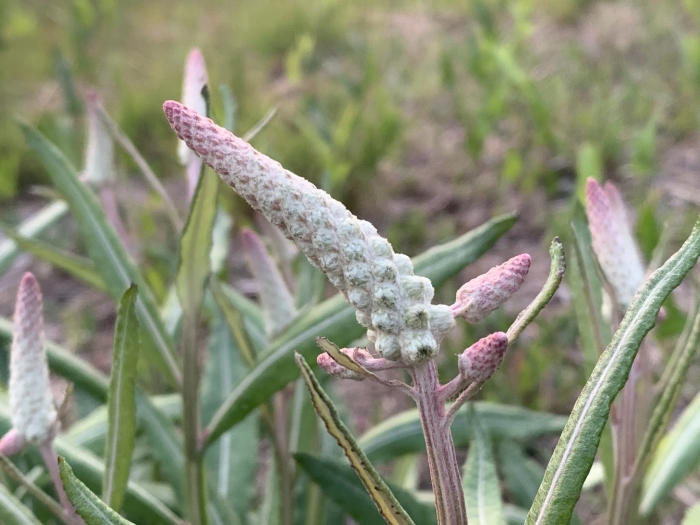Dense-Spike Blackroot
(Pterocaulon pycnostachyum)
Dense-Spike Blackroot (Pterocaulon pycnostachyum)
/
/

natalie
Public Domain
Image By:
natalie
Recorded By:
Copyright:
Public Domain
Copyright Notice:
Photo by: natalie | License Type: Public Domain | License URL: http://creativecommons.org/publicdomain/zero/1.0/ | Rights Holder: natalie | Publisher: iNaturalist | Date Created: 2021-03-27T23:31:13Z |



















































Estimated Native Range
Summary
Pterocaulon pycnostachyum, commonly known as Dense-Spike Blackroot, is a deciduous perennial herb or subshrub native to pine flatwoods, savannas, and other open, sandy habitats in the Southeastern United States. It typically grows up to 80 cm (31 inches) tall and is characterized by stems and the undersides of leaves covered with a thick, white layer of woolly hairs. The flower heads are crowded into a densely packed spike at the tips of the branches, each containing up to 50 small yellowish flowers. The plant is monoecious, with male and female reproductive structures in separate flowers on the same head. Flowering occurs in the summer and the blooms are not particularly showy, but they do attract pollinators such as bees and butterflies.
Dense-Spike Blackroot is valued for its adaptability to poor, sandy soils and its use in naturalistic plantings and restoration projects. It is drought-tolerant once established, making it suitable for xeriscaping. In cultivation, it thrives in full sun to part shade and prefers soils with medium to fast drainage. While it is not commonly used in ornamental horticulture, its resilience and unique foliage texture can add interest to native plant gardens and informal borders. Care should be taken as it can spread in favorable conditions, potentially becoming weedy.CC BY-SA 4.0
Dense-Spike Blackroot is valued for its adaptability to poor, sandy soils and its use in naturalistic plantings and restoration projects. It is drought-tolerant once established, making it suitable for xeriscaping. In cultivation, it thrives in full sun to part shade and prefers soils with medium to fast drainage. While it is not commonly used in ornamental horticulture, its resilience and unique foliage texture can add interest to native plant gardens and informal borders. Care should be taken as it can spread in favorable conditions, potentially becoming weedy.CC BY-SA 4.0
Plant Description
- Plant Type: Herb, Subshrub
- Height: 1-2 feet
- Width: 1-4 feet
- Growth Rate: Moderate
- Flower Color: White
- Flowering Season: Spring, Summer
- Leaf Retention: Deciduous
Growth Requirements
- Sun: Full Sun, Part Shade
- Water: Low, Medium
- Drainage: Medium, Fast
Common Uses
Bee Garden, Border Plant, Butterfly Garden, Low Maintenance, Rock Garden
Natural Habitat
Native to pine flatwoods, savannas, and open, sandy habitats in the Southeastern United States
Other Names
Common Names: Fox-Tail, Coastal Blackroot, Fox-Tail Blackroot
Scientific Names: , Pterocaulon pycnostachyum, Pterocaulon undulatum, Chlaenobolus undulatus, Conyza pycnostachya, Gnaphalium undulatum, Chlaenobolus pycnostachyus, Pluchea pycnostachya,
GBIF Accepted Name: Pterocaulon pycnostachyum (Michx.) Elliott